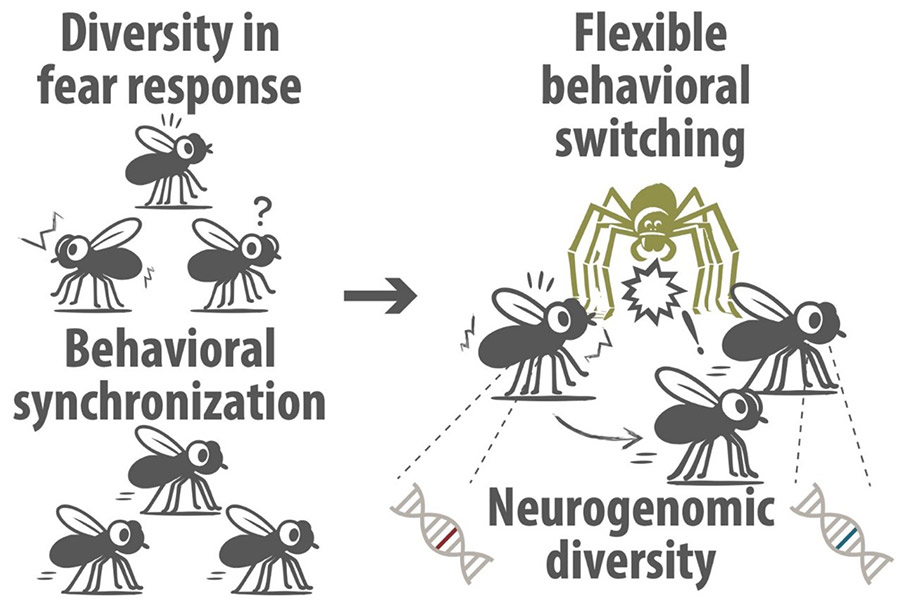Genetic diversity in groups of flies helps them evade predators and forage more efficiently through synchronized behaviors
Collective animal behaviors help groups avoid predators and forage more effectively, but their genetic basis is poorly understood. In a recent study, researchers explored this phenomenon using fruit flies, revealing that genetic diversity within groups enhances survival through coordinated fear responses. By combining large-scale behavioral tests and a new approach to genome-wide analyses, the researchers uncovered key genes and neural mechanisms behind group dynamics, offering insights relevant to ecology, pest control, and human social behavior.

Image title: Behavioral diversity coupled with synchronization benefits the group
Image caption: The study reveals that behavioral diversity and synchronization are key to enhancing behavioral flexibility in fly groups, promoting predator avoidance and efficient exploration.
Image credit: Assistant Professor Daiki Sato from Chiba University, Japan
Image source link: N/A
Image license: Original content
Usage restrictions: Cannot be reused without permission.
From schools of fish darting away from sharks to flocks of starlings swirling through the sky, the animal kingdom is full of examples of how group behavior offers a survival advantage. Through collective behaviors, animals can more effectively spot approaching predators and coordinate their escape, increasing their odds of survival and making foraging more efficient. Although we can observe such group dynamics everywhere, the genetic and neural mechanisms underlying collective behaviors remain largely unknown.
This is because understanding the relationships between the brain and genes that shape group behaviors presents unique challenges. Conventional genetic analyses excel at linking genomic variation to an individual’s traits, but group behaviors emerge from complex interactions between multiple individuals with different genomes. Thus, genome-wide association studies (GWAS), which have helped us identify genes for thousands of traits and diseases, struggle to capture emergent group-level properties that can’t be reduced to simple individual characteristics.
To tackle this challenge, a research team led by Assistant Professor Daiki Sato and Associate Professor Yuma Takahashi from Chiba University, Japan, turned to an unlikely subject: the fruit fly. In a groundbreaking study published in Nature Communications on July 07, 2025, they explored how fruit flies coordinate their fear responses when facing predators. Combining large-scale behavioral experiments with cutting-edge genomic analysis, the researchers uncovered fundamental principles about how genetic diversity within groups can create survival advantages.
The team conducted an ambitious experiment involving 104 genetically distinct lines of fruit flies, observing how individual flies and groups responded to predator attacks simulated using expanding shapes on a screen. Strikingly, while individual flies would freeze in fear for extended periods, flies in groups quickly resumed normal activity after detecting movement from their companions. This ‘unfreezing’ behavior depended critically on visual cues—namely, the movements of nearby individuals.
Using GWAS, the researchers identified specific genes that control how flies respond to their group mates. In particular, the Ptp99A gene showed strong associations between both male and female flies. This gene encodes a protein that regulates specific cellular and neural functions. By conducting behavioral experiments on flies with altered visual system function, the researchers found that Ptp99A influences gene expression in lamina neurons, which are involved in the fly’s visual system that process motion detection.
The team also introduced a new analytical approach called genome-wide higher-level association study (GHAS), designed to capture higher-order biological traits that emerge at the group or population level. This method identifies genetic variants linked not to individual traits but to emergent group properties, analyzing the relationship between differences in specific genomic regions and the resulting behavioral diversity effects in mixed groups. “The GHAS method we developed could be extended to other species and contexts, allowing researchers to examine how genetic diversity shapes coordination, resilience, and performance in biological collectives,” notes Dr. Sato.
Most remarkably, the study revealed that genetic diversity within groups alters collective behaviors to enhance survival performance. When researchers created mixed groups using flies from two genetically distinct lines, these diverse groups showed stronger initial fear responses than expected, based on the average response of single-line groups. This enhanced response actually proved beneficial for survival, which the researchers proved in an interesting way.
The researchers used an animal-computer interaction approach, which involved displaying virtual flies on screens and observing how real jumping spiders responded to different behavioral patterns. The virtual flies were programmed to freeze for varying durations when the spider approached. The results showed that when there was variation in freezing duration among individuals combined with sufficient levels of behavioral synchronization, groups gained significant advantages—reducing predation risk while maintaining mobility for essential activities like foraging.
“This research lays the groundwork for understanding how genetic and neural diversity contribute to adaptive collective behaviors,” explained Dr. Sato. These newfound insights could be applied to multiple fields, including pest management strategies, robotics, and artificial intelligence, to design swarm systems and understand neurodevelopmental disorders.
Overall, this research marks significant progress in understanding the biological basis and evolution of group behaviors. With any luck, we might be able to replicate these findings in other species and find creative ways to leverage this knowledge.
About Assistant Professor Daiki Sato
Dr. Daiki Sato is an Assistant Professor at the Graduate School of Science at Chiba University, Japan. His research focuses on evolutionary genomics, as well as the genetic, molecular, and ecological mechanisms underlying emergent properties of collective behavior.
Funding:
This work was supported by the Japan Society for the Promotion of Science (Grants-in-Aid for Scientific Research JP22K15181 to D.X.S. and JP22H05646, JP23H03839, JP23H03840, and JP23H02550 to Y.T.), the Japan Science and Technology Agency (Strategic Basic Research Programs ACT-X JPMJAX24L7 to D.X.S.), and the Sasakawa Scientific Research Grant from The Japan Science Society (to D.X.S.).
Reference:
Title of original paper: Neurogenomic and behavioral principles shape freezing dynamics and synergistic performance in Drosophila melanogaster
Authors: Daiki X. Sato1,2 and Yuma Takahashi2
Affiliations: 1Institute for Advanced Academic Research, Chiba University
2Graduate School of Science, Chiba University
Journal: Nature Communications
DOI: 10.1038/s41467-025-61313-z
Contact: Daiki Sato
Institute for Advanced Academic Research/Graduate School of Science, Chiba University
Email: daiki.sato12@gmail.com
Public Relations Office, Chiba University
Address: 1-33 Yayoi, Inage, Chiba 263-8522 JAPAN
Email: koho-press@chiba-u.jp
Tel: +81-43-290-2018
Recommend
-

Safeguarding Lifelines: Rapid Restoration of Infrastructure in Earthquake-Prone Japan
2024.10.21
-

Harnessing CO2 with a Photocatalyst for Fuel and Plastic Feedstocks: Advancing a Sustainable Society with Chemistry
2023.06.22
-

Viewing a Diverse World through the Lens of Agriculture and Food: Enriching Global SDGs Education with Insights from Extensive Overseas Field Research
2023.08.31


